Driving back to Flagstaff on Saturday, BD studied the map, discovering Wupatki National Monument on the east side of 89. “Want to see it?” he asked, to which I replied, it would depend on what the guide books said. We had 3 more touring days left plus a day to blast back to Nevada so we could catch our plane on Thursday – and Arizona is an enormous state. And the truth was – I was tired and just a little homesick. Himself was even worse off since he dreaded the flight back. He hates flying, which makes him feel constrained though he feels a sense of freedom when traveling by car. I, otoh, feel constrained by distance when traveling more than 2 days by car so when there's a lot of miles to cover, I prefer flying. Long marriage. Much compromise.
But when he confessed he was ready to go home I pointed out that, in fact, we had trip insurance. We didn't have to see anything else. We could go to the airport, change our tickets and be home in 2 days. Two days of something as mind boggling as the Grand Canyon is really enough to put into your brain. Adding more can sometimes blur the new information. Data overload, sensation overload too, is not always a refreshing vacationing experience.
 In the end, though, we decided to stay and explore some of the other wonders in Arizona. Native American wonders. Geological wonders. With so little organic mass out there, whatever is there doesn't tend to wear away – at least, not in a human sized timeline. And when I flipped open the DK Eyewitness travel guide to Arizona & the Grand Canyon there was Wupatki NM with a photo of a 12th century publo – and I was captured.
In the end, though, we decided to stay and explore some of the other wonders in Arizona. Native American wonders. Geological wonders. With so little organic mass out there, whatever is there doesn't tend to wear away – at least, not in a human sized timeline. And when I flipped open the DK Eyewitness travel guide to Arizona & the Grand Canyon there was Wupatki NM with a photo of a 12th century publo – and I was captured. The guidebook also had a photo of the cliff dwelling at Montezuma's Castle, south of Sedona and that NP opened at 8 a.m. So after a good night's sleep we decided to head south, down 89A, instead of the faster interstate 17. (We're suckers for the scenic route) BD drove and I tried to figure out how to find the highway as we idled at a stoplight when a police car pulled up beside us and honked. I have never really gotten over that feeling that I might be doing something wrong whenever I encounter a policeman in a car – though I never feel that way when I meet them anyplace else, all the policemen I've known have been really nice people and I don't drive recklessly. There's just something about cars and their machine parts and rules and Other People that I don't fully trust so that when I'm on the road I always feel a little like I'm ... underage. Anyway – the man asked if we needed directions, I told him we were looking for 89A, he asked “Sedona?” and I nodded. He turned us around and we were on our way in a flash. Just one more experience of the friendly people of Flagstaff – and of AZ altogether.
The road snaked along Oak Creek Canyon, with so many switchbacks it was like the S. Kaibob trail for cars. It lead us through the most amazing rock formations. These were mostly deep red, much more rounded than the huge flat faced red rocks in the GC. Many of them looked like fortresses or cathedrals and I laughed when I discovered the most obvious formation, anchoring the Sedona landscape was called just that - “The Cathedral”
Sedona is the only really beautiful town I saw out west. I saw beautiful things everywhere we went, but they were 100% nature made, not man made. I suppose when there is so little building material, it's difficult to build beautiful things. Of course, if there is enough money, you can make almost anything beautiful and the folks in Sedona have carried their good taste and aesthetic eye even to the gas stations and convenience stores. The little town of Oak Creek, just south of Sedona is equally pretty and either one looked tempting enough to get me back out west.
But I wanted to see a cliff dwelling. I have actually wanted to see a pueblo ever since 4th grade, when I saw my first photograph of one, in my geography book and we still had a good many miles to go. South of Oak Creek we had to rejoin fast I-17 and drive another dozen or so miles to Middle Verde where signs directed us to the park. And here I found the most exquisite microcosm in the entire trip.
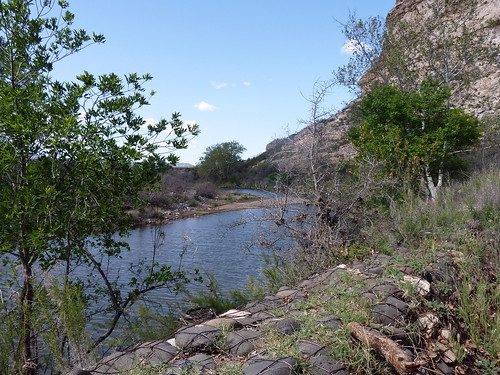 A feeder creek into the Verde River flows through a narrow valley, making the ground wet enough to support sycamore trees and blossoming flowers, as well as the ubiquitous juniper and the twisty pinion pines. There's a short walk from the visitor center to the opening of this narrow valley and then you see it.
A feeder creek into the Verde River flows through a narrow valley, making the ground wet enough to support sycamore trees and blossoming flowers, as well as the ubiquitous juniper and the twisty pinion pines. There's a short walk from the visitor center to the opening of this narrow valley and then you see it. 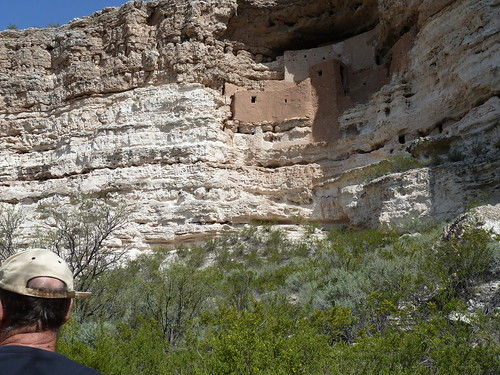 What you see is a cliff dwelling some 75-100 feet above the valley floor. It will take your breath away. In its way it's as impressive as the GC. It dates from about the 12th century, like all the native American structures you'll encounter. Humanity seems to have slid into this dessert world around the year 1,000 and was mostly gone by 1400. Speculation about both arrival and departure includes both societal pressure and climate change. All I know is that – here was the only place where I felt like I could move right in. This was another place where I didn't just look, but opened up my soul to whatever residue of times gone by still lingered. Everything about this little valley felt welcoming.
What you see is a cliff dwelling some 75-100 feet above the valley floor. It will take your breath away. In its way it's as impressive as the GC. It dates from about the 12th century, like all the native American structures you'll encounter. Humanity seems to have slid into this dessert world around the year 1,000 and was mostly gone by 1400. Speculation about both arrival and departure includes both societal pressure and climate change. All I know is that – here was the only place where I felt like I could move right in. This was another place where I didn't just look, but opened up my soul to whatever residue of times gone by still lingered. Everything about this little valley felt welcoming.I have no romantic illusions about the primitive life. It's a hard, monotonous and frightening world. To think that ancient societies were somehow as free as the birds is, while silly, also accurate – because both have to spend almost every waking hour struggling for food. Both are utterly subservient to weather. One bad year of drought will lay them low – a few in a row will wipe them out.
Still – this place? Lawsie – something about this place is just so perfect, so beautiful, so gentle in such an incredibly harsh landscape – I can only call it – Shangri La.
We went back out onto the interstate, and north, to visit Montezuma's Well. This is a volcanic lake surrounded by cliff dwellings – still considered a holy place by the Hopis, as would be expected, since finding deep blue water in the middle of this brown world always seems a little heaven sent. As we found in all the parks, the rangers were extremely well informed and very personable. I'm sure they are screened for brains and personality because 100% of the ones we met added richly to our travels.
At the entrance booth there was a herpetologist's who had captured a 4 ft. rattlesnake and put it into a long clear tube. He was measuring it and tagging it so its movement could be monitored. I'm not creeped out by snakes. I trust them to slither away from me if they have any opportunity. Still – with it's buff color a perfect camouflage, I'm glad he was not lying across my path.
 The well is a deep lake of clear blue water. There is 19th century graffiti along the rock walls at its base, where more dwellings were once built into the cave like rock formations. There are also turtle traps – because non-native turtles have been released into the water and they compete with the native turtle. I found it a little bizarre to think someone would drive this far out into the dessert to get rid of an unwanted pet turtle but there you have it – how else could one get so far? We covered all the paths at this site, again, opening up to whatever spiritual messages we might encounter.
The well is a deep lake of clear blue water. There is 19th century graffiti along the rock walls at its base, where more dwellings were once built into the cave like rock formations. There are also turtle traps – because non-native turtles have been released into the water and they compete with the native turtle. I found it a little bizarre to think someone would drive this far out into the dessert to get rid of an unwanted pet turtle but there you have it – how else could one get so far? We covered all the paths at this site, again, opening up to whatever spiritual messages we might encounter. 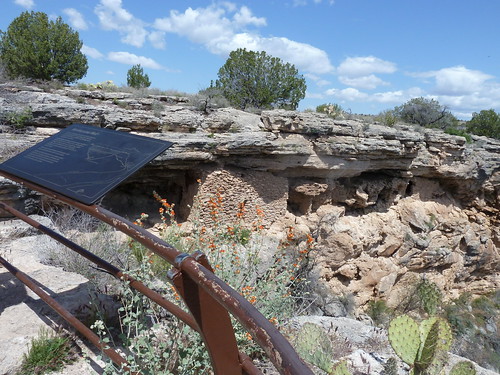

 It was after noon by then and we headed north, this time taking fast I-17, to visit Sunset Crater and Wupatki NP, north of Flagstaff on 89. The crater was created during the most recent eruption in this part of AZ, about 1100 – right when everything seemed to be happening out here. The information pamphlet we picked up at the visitor center told us a little history and a little geology but nothing prepared us for that first view of the lava fields. My goodness! They look like coal slag – black rocks spewed everywhere. What little life has come back in the past 900 years seems almost artificial as it pops up out of the black cinders. Right beside this little yellow flower I dug down 4 inches with my finger, through ever shrinking little balls of rock. Obviously there's some organic matter down there somewhere, but I didn't find it.
It was after noon by then and we headed north, this time taking fast I-17, to visit Sunset Crater and Wupatki NP, north of Flagstaff on 89. The crater was created during the most recent eruption in this part of AZ, about 1100 – right when everything seemed to be happening out here. The information pamphlet we picked up at the visitor center told us a little history and a little geology but nothing prepared us for that first view of the lava fields. My goodness! They look like coal slag – black rocks spewed everywhere. What little life has come back in the past 900 years seems almost artificial as it pops up out of the black cinders. Right beside this little yellow flower I dug down 4 inches with my finger, through ever shrinking little balls of rock. Obviously there's some organic matter down there somewhere, but I didn't find it.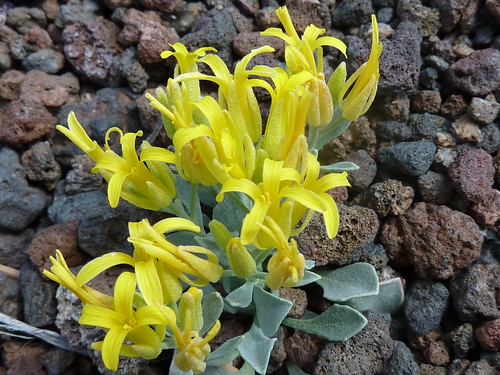
And then it was north, along the 35 mile long loop road into the land of pueblos. We visited them all, the Wukoki, The Wupatki, the Citadel and the Lomaki as well as the dwellings in Box Canyon. The most amazing was the Wupatki, because it was so big. It included 2 kivas, one circular, one square, a ball court and a “blow hole” a geological anomaly that taps into underground air and, depending on the air pressure, either sucks in or blows out. On our visit it was blowing out and children were leaning over it as their hair blew back. So did I! It was fast blowing and cool. The ranger told us there had once been 3 springs around this pueblo but after 19th century cattle grazers tried to enlarge the springs, they disappeared.
 |
| That's me waving in the doorway |
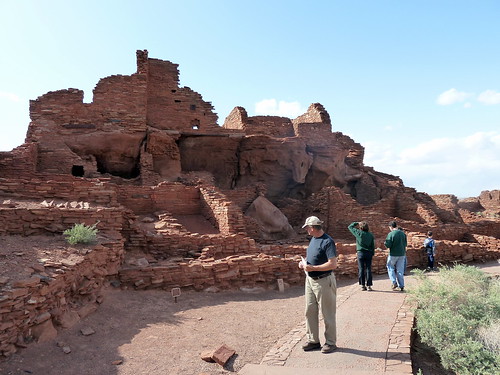
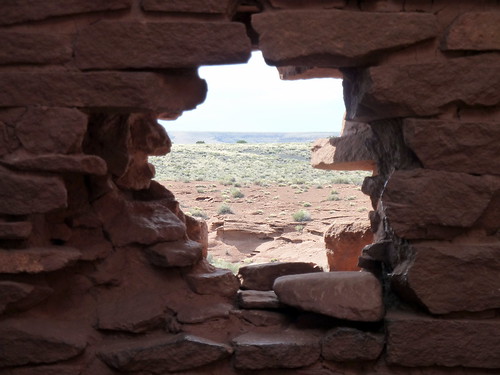
All that day a tremendous wind blew. Sometimes it blew chilly, sometimes the sun warmed it up a bit, but the power of that wind was something I'd never experienced before. At the Citadel – a very high rock formation with the remains of a pueblo on top – it blew so hard I couldn't hold the camera to take a photo. In fact – it blew so hard I heard its message to get off that rock – and believe me – when nature tells me something that succinctly, I obey.
There was none of that feeling of homecoming here, in this bleak landscape, that I'd found in Montezuma's Castle. There had been only 1 inch of rain since January 1. It was hard to imagine living in such a landscape, much less traveling to and trading with the different villages. Yet – people are both indomitable and societal – and legs can carry them far and wide. And these ruins certainly offer a window onto that world of 900 years ago. One of the constant emotions pulsing through me during this whole day was a thankful respect to those who had come before, living a life that had meaning and joy and power in a landscape so vast and open.
We headed back to Flagstaff around 7 o'clock, coming in on the east end of town, after seeing only half of the things we'd mapped out the night before. We stayed in the Howard Johnson – which had been given more stars than it deserved on the travel booking websites. It was okay – but eh – not as nice as the Econo Lodge University on the west end of town and, unbeknown to us, was right next to a restaurant/club that booked a raucous mariachi band who played unceasingly and loudly till 2 a.m. No. I did NOT get much sleep that night. Eh. Travel. It makes you tolerant.
I'm still loading More Photos on my flicker page so if you're curious click here. And tomorrow? The Meteor Crater and the Petrified Forest.
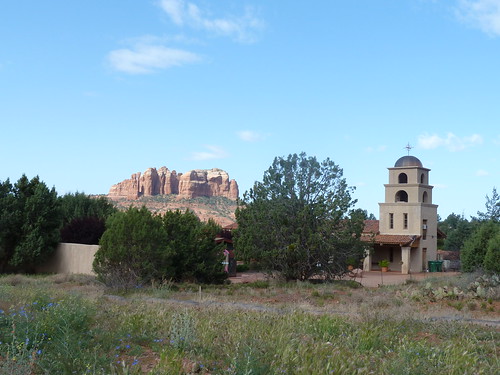
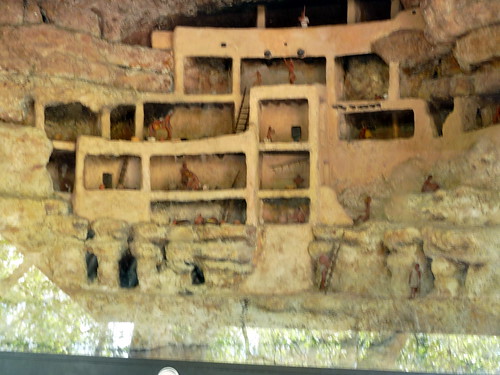
No comments:
Post a Comment